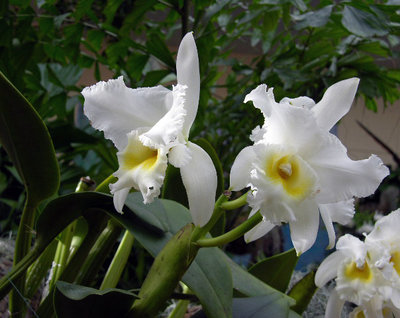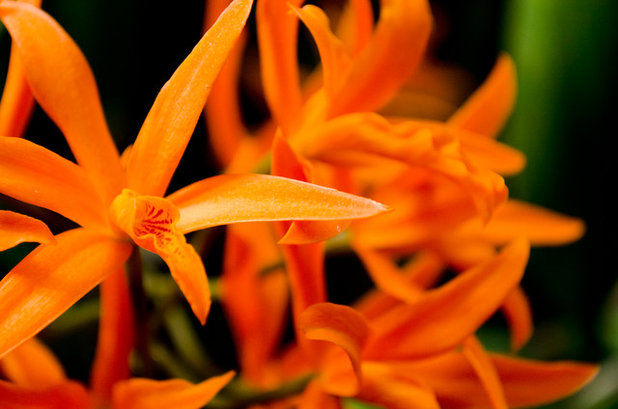Cattleyas epitomize orchids to most people. Even the color called “orchid” takes its name from the the pink to purple shade of the familiar cattleya orchid used in corsages. Nowadays, though, you’ll find cattleyas in almost any color and with a variety of markings. You’re also likely to find hybrids, such as the genus
Laelia; the bonus is more variety with the same easy-care culture.
Once you get the hang of it, cattleyas are relatively easy to grow. They aren’t quite “place and forget” plants, but they aren’t as fussy as you might imagine. Plus, if you do grow them, think of the bragging rights. Not everyone can grow their own corsages at home.

The New York Botanical Garden
Cattleyas also offer a lot of variety. The plant sizes range from a few inches up to around 4 feet tall. The flowers, too, can vary from tiny to fairly large. Even bloom times differ, with some blooming near Christmas and others showing off their blossoms in summer.
Like other orchids, cattleyas and their hybrids prefer bright light and some humidity, but they can be remarkably tolerant of a bit of a range. Start by choosing a good location. Cattleyas like plenty of light, so a south- or west-facing window is ideal. That said, you don’t want to burn them, so you may need to pull them back a bit or provide a thin filter such as a gauzy curtain if they’ll get direct afternoon sun, especially in summer.
Remove the blooms once they fade. If the plants aren’t blooming, increase the amount of light they receive.

Missouri Botanical Garden
Cattleyas also like indoor temperatures that are comfortably warm. Their ideal is a nighttime low of 55 to 60 degrees Fahrenheit (13 to 16 degrees Celsius), with warmer temperatures up to 85 degrees Fahrenheit (30 degrees Celsius) during the day. They can even handle fairly high summer temperatures, up to 95 degrees Fahrenheit (35 degrees Celsius) during the day for brief periods of time.
As with other orchids, higher temperatures should be accompanied by higher humidity and good air circulation. Misting the leaves in the morning or growing the plants on trays filled with pebbles and water, as long as the pots aren’t touching the water, can help raise humidity, and opening windows or using a small fan will help circulate the air.

Missouri Botanical Garden
Like most other orchids, cattleyas prefer that you water by flooding the pot, then letting the mixture drain thoroughly so it isn’t soggy or overly wet. Unlike many other orchids, cattleyas are happier if they dry out a bit between waterings; only water them when at least the first inch of the potting medium is dry.
When the orchid is growing in spring and summer, feed when you water with a quarter-strength balanced fertilizer. Cut back to the same amount of fertilizer every other time you water in fall and winter.

Missouri Botanical Garden
Repot only when the roots are very crowded, usually every two or three years; cattleyas do best in a slightly small pot. Use a bark or bark-perlite mixture for the best results, and repot after blooming has ended.
More: Orchids 101: Get Started Growing Orchids at Home
More guides to growing houseplants





